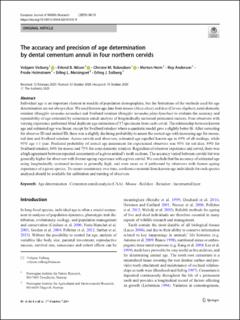The accuracy and precision of age determination by dental cementum annuli in four northern cervids
Veiberg, Vebjørn; Nilsen, Erlend Birkeland; Rolandsen, Christer Moe; Heim, Morten; Andersen, Roy; Holmstrøm, Frode; Meisingset, Erling L.; Solberg, Erling Johan
Peer reviewed, Journal article
Published version

Åpne
Permanent lenke
https://hdl.handle.net/11250/2685226Utgivelsesdato
2020Metadata
Vis full innførselSamlinger
- Publikasjoner fra CRIStin - NINA [2364]
- Scientific publications [1392]
Originalversjon
10.1007/s10344-020-01431-9Sammendrag
Individual age is an important element in models of population demographics, but the limitations of the methods used for age determination are not always clear. We used known-age data from moose (Alces alces), red deer (Cervus elaphus), semi-domestic reindeer (Rangifer tarandus tarandus) and Svalbard reindeer (Rangifer tarandus platyrhynchus) to evaluate the accuracy and repeatability of age estimated by cementum annuli analysis of longitudinally sectioned permanent incisors. Four observers with varying experience performed blind duplicate age estimation of 37 specimens from each cervid. The relationship between known age and estimated age was linear, except for Svalbard reindeer where a quadratic model gave a slightly better fit. After correcting for observer ID and animal ID, there was a slightly declining probability to assess the correct age with increasing age for moose, red deer and Svalbard reindeer. Across cervids and observers, estimated age equalled known age in 69% of all readings, while 95% age ± 1 year. Predicted probability of correct age assessment for experienced observers was 93% for red deer, 89% for Svalbard reindeer, 84% for moose and 73% for semi-domestic reindeer. Regardless of observer experience and cervid, there was a high agreement between repeated assessments of a given animal’s tooth sections. The accuracy varied between cervids but was generally higher for observers with former ageing experience with a given cervid. We conclude that the accuracy of estimated age using longitudinally sectioned incisors is generally high, and even more so if performed by observers with former ageing experience of a given species. To ensure consistency over time, a reference material from known-age individuals for each species analysed should be available for calibration and training of observers. Age determination . Cementumannuli analysis (CAA) . Moose . Red deer . Reindeer . Incremental layer
